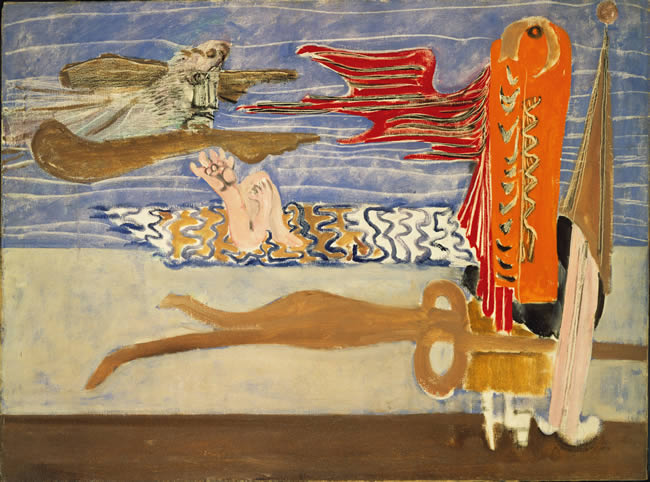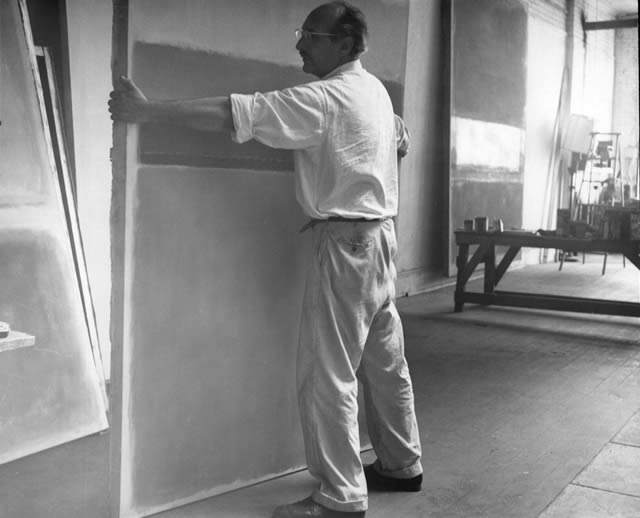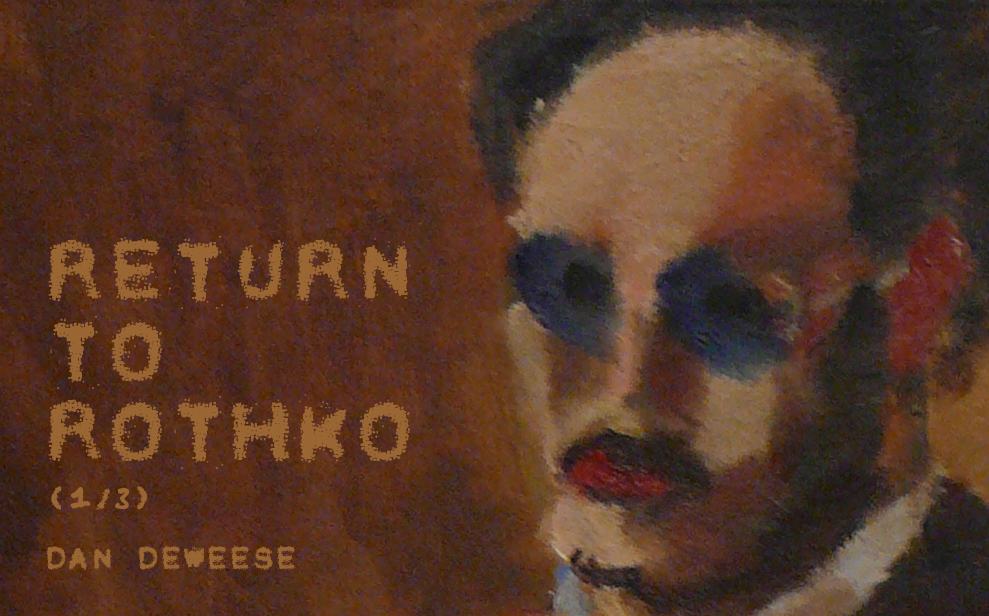(This is the first of a three-part essay on Mark Rothko, occasioned by the Portland Art Museum's retrospective of the artist's work. The author will return to the show in April to produce part two and return again in May for part three, in an attempt to explore how thoughts on the exhibition, reception, and meaning of art change according to time and context.)
 There is no such thing as good painting about nothing. We assert that the subject is crucial and only that subject matter is valid which is tragic and timeless… Consequently if our work embodies these beliefs it must insult anyone who is spiritually attuned to interior decoration; pictures for the home; pictures for over the mantle; pictures of the American scene; social pictures; purity in art; prize-winning potboilers; the National Academy; the Whitney Academy; the Corn Belt Academy; buckeyes; trite tripe; etc.”
There is no such thing as good painting about nothing. We assert that the subject is crucial and only that subject matter is valid which is tragic and timeless… Consequently if our work embodies these beliefs it must insult anyone who is spiritually attuned to interior decoration; pictures for the home; pictures for over the mantle; pictures of the American scene; social pictures; purity in art; prize-winning potboilers; the National Academy; the Whitney Academy; the Corn Belt Academy; buckeyes; trite tripe; etc.”
—from a letter dated June 7, 1943, and signed by Adolph Gottlieb and “Marcus Rothko,” in response to a negative review in the New York Times
There’s a Rothko exhibition at the Portland Art Museum, and it’s safe to assume it would pain him. Considering the number of home makeover shows on television, a reliable percentage of the exhibition’s attendees probably qualify as the people Rothko labeled above as “spiritually-attuned to interior decoration”—but despite his prediction, I observed not a single person who seemed insulted. Poster-sized prints of Rothko paintings have served as pictures for people’s dorm rooms, offices, and homes for decades, of course, sometimes over mantles. The abstract expressionists living, working, and exhibiting in New York post-World War II are thought of as having comprised their own “American scene,” and people—young people, especially—are often drawn to abstract expressionism at the same time they pursue early interests in “classic jazz,” European art cinema, beat poetry, and other greatest hits of post-WWII culture, by which I mean, in a phrase probably untoppable in its evocative accuracy: “The Birth of the Cool.” Continuing through the passage above, most people think of Rothko’s work as centered on a search for “purity in art,” and it’s unavoidable in any chronologically-organized retrospective museum exhibition not to view the paintings as items of evidence produced by the “potboiler” that is the story of the artist’s life. (It’s even more difficult to resist this when the artist’s life ended in suicide.) Finally, Rothko’s importance has been acknowledged by pretty much every academy one can think of, though I’ll admit I didn’t confirm with the Corn Belt Academy, failing to find any evidence of its existence.
Critics have exhaustively noted, analyzed, and theorized the distorting effects of museum shows that must be marketed and profitable, whose gift shops include greeting card versions of the art, and which provoke a nostalgia-clouded view that suggests the artist’s biography reveals his or her intentions. These issues are—in another succinct phrase that crops up often enough in contemporary criticism that it’s probably this phrase itself that is the cultural challenge of our time—always already part of our contemporary experience of art. The only way for the Portland Art Museum to gather forty-five Rothko pieces at one time is to lay biographical claim to him (he lived in Portland from age ten, when he emigrated from Russia, until seventeen, when he graduated high school and left for Yale), but the exhibition does an admirable job of not making too much of this, since Rothko’s artistic community and aesthetic breakthroughs occurred on the East Coast, and it would be silly to pretend otherwise. The forty-five paintings are packed shoulder to shoulder along the IKEA-esque switchbacks museums employ to coax more walls into limited space, and the work is a representative selection that gives visitors a good sense of the subjects, compositions, and techniques Rothko worked through on his way to finding the iconic form for which he became famous.
So why did I walk away feeling low? Seeing these paintings together right down the street from where I work is an opportunity. Over the next couple months I can slip back in and look at them as many times as I like. And yet when I went back to look at the show a second time, it was with reluctance. I moved through quickly, confirmed a few things, and left, as if hoping to outrun something.
The reasons for this response are possibly childish or naïve. I am not a religious person. I believe most of the creative work we do in our lives will be forgotten, and that our social, professional, and creative personas often turn into parasites that first feed on and then devour our consciousness. But even before I had ever seen a Rothko painting in person—when I was just a kid paging through art books in a small-town library—I had admired the work I sensed lay behind finding that final form, and the care that went into the choices about color and size. Later, when I was in my mid-twenties, I turned a corner in the San Francisco Museum of Modern Art, walked unexpectedly into a room with a large Rothko, and was able to look at it for only a few minutes before I had to leave, lest I be caught on the verge of tears. The painting had a power I hadn’t expected—a presence that, in some mute way, spoke to me. So I believe in Mark Rothko. I believe in his project, and I believe in his results.
But recently, as I stood in the Portland Art Museum and for the first time in a number of years came face to face with some of these paintings again? I didn’t feel anything. And that was frightening.
Wikipedia’s current entry on Rothko includes this sentence: “As a result, Rothko’s work became increasingly abstract; perhaps ironically, Rothko himself described the process as being one toward ‘clarity.’” Rothko's reputation is secure. He doesn’t need anyone to attack Wikipedia in defense of his work, methods, or the meaning of anything he said. Yet I still want to take a marker to the screen and line out “perhaps ironically”. Why does this artist provoke in me such a defensive response? It’s difficult to describe to anyone who feels the work is boring, or that their kid could do these paintings. (I’ll accept the former, by the way, because we can't all be moved by the same things, but the latter? No.) The brief explanation is simply that the things you’ve read or heard about the paintings possessing indefinite or shifting depths, or a sense that they have a power to envelop or challenge the faculties of the viewer: I’ve felt that. I am one of those people who doesn’t just like Rothko, but who feels, depending on the day and how many drinks I've had, that he either: a) may have pushed painting to a kind of terminal expressive point beyond which it’s not possible to go, and which painters since Rothko have avoided; or b) wasn't really painting at all in the end, but doing something closer to sculpture—dragging, via an act of will, unnamable energies into material existence.
People who thought the paintings were purely exercises in color and composition were missing the point, Rothko said—he was after something bigger than that. This doesn’t mean, however, that color and composition weren’t necessary for him to find his way there. The colors, forms, layers of paint, canvas size: all are elements of the alchemy he hit upon, and if they are not sufficient for the alchemy, they are at least necessary. Rothko claimed the paintings he made in his final period were neither abstract nor expressionist—my parsing of that is though some of their power still lays in the way they produce reflection on the material conditions of their creation (one of the short definitions of abstract expressionism), Rothko wanted viewers to respond with something far different from thoughts about which colors go nicely together. Because there is nothing representational in Rothko’s late work to cast the mind in the direction of literal interpretation ("Ah, a bowl of fruit"), the relationship between the eye and the painting is direct, and Rothko hoped that in the directness of that relationship, viewers would not think, but feel. Recognizable figures in the paintings would only distract viewers from this response, so when Rothko spoke about leaving behind symbols and moving toward abstraction as an act of clarity, and the anonymous Wikipedia author speculates that Rothko said this “perhaps ironically”? Well: no. Figures were in the way, so he dispensed with them. He was speaking plainly.

Rothko's "Iphegenia and the Sea/Horizontal Phantasy" (1943). Rothko would soon decide figures and symbols were in the way, and would dispense with them.
This is why I suspect Rothko would dislike the Portland Art Museum exhibition. He wanted viewers to be moved, spoke often of hoping to provoke something spiritual, but responding to a painting in that way is only possible under certain conditions. Toward the end of his life, Rothko was accordingly interested in controlling the conditions under which his work would be viewed, and though he didn’t live to see the Rothko Chapel in Houston, he was working in his mind (and with architects) on designing ideal rooms for his work. The paintings in the Portland Art Museum are all in the same room, though, under the same light. It’s not the light Rothko believed was best for his late work, and the snaking switchbacks of image-heavy walls bear little resemblance to Rothko's desired rooms.
The kind of quiet time with a painting that is necessary for one to be moved is also difficult when the painting is part of a major exhibition whose purpose is to draw a crowd. I'm hardly innocent of contributing to the distracting crowd factor, of course—in addition to personally being one of the crowd, the first time I went to see the exhibition I brought my kids, one of whom had been clear about his opposition to spending time at the museum that afternoon. He expressed his discontent by sitting on a bench and playing video games while I looked at the paintings. So the young Philistine with the tablet computer and the earbuds? Sorry—mine. This, in a way, is part of the paradox: the only way we can leverage a request to have a Rothko show of this magnitude in Portland is under these conditions, and the Portland Art Museum has done the work of making this happen for us. But under these conditions—in crowded corridors, on crowded walls—we may not really be seeing the paintings.
Do we have a right to expect something different, though? The museum must work with the building it has, and it strikes me that were I challenged to suggest better placement and lighting for the pieces, the unspoken ideal lurking in my mind is nothing more than the common joke made in museums: I think the Seagram mural sketches would look better on the walls of my living room. That I seriously believe this—that I could go on about how the lighting in my living room is better, contemplation of the piece wouldn’t be broken by crowds or by the distraction of dozens of other Rothkos surrounding it, and that shifts in light due to time of day or season would bring out different aspects of the pieces—doesn’t make it any less laughable. The astronomical prices the rich pay at auction for famous paintings is just a symptom of the fetish most of us invest in art: we believe, deep down, that images we find important belong to us in some way, and that we know how these images should be presented. We believe that because we care about them, we must also know how to care for them.
This isn't necessarily true. Likewise, there may be visitors moved by Rothko’s pieces regardless of the crowds and corridors, or people who find quieter hours during which to visit. There is also a part of most of us that is happy to acquire biographical or scholarly information about a “major artist,” regardless of our thoughts on ideal exhibition. This part of us associates museums with schools, and it may be that education is indeed what museums do best. To ask more of them is perhaps to misunderstand their function.
So the sadness I felt upon leaving the exhibition wasn’t a shared public sadness—others probably left in a perfectly fine mood—so much as it was about a private sense of failing to find an important part of myself. Rothko has been, at other times, in other places, a powerful experience for me. His late paintings were brooding icons that confirmed the possibility that if one worked, and endured, and yes, believed—then a connection could be made. I felt that connection with the Rothko I walked away from in San Francisco, and I felt it with Rothkos I saw elsewhere, later. To visit the paintings but not feel the connection, then, is unsettling: it suggests that either the connection is gone, or worse, that I only imagined it in the first place. Rothko said the late paintings do have content, and I agree. If it turns out this is wrong, and the canvases are just Rorschach tests meant to invite viewers’ projections, then I have fooled myself, and there is no actual possibility for connection via art—or one less possible connection, at least, among what sometimes seems a dwindling list.

Mark Rothko holding Untitled (1954).
Rothko said: “I’m interested only in expressing basic human emotions—tragedy, ecstasy, doom, and so on. And the fact that a lot of people break down and cry when confronted with my pictures shows that I can communicate those basic human emotions...The people who weep before my pictures are having the same religious experience I had when I painted them.” What happens, though, if we know the point, but we don’t feel it? It’s possible Rothko would have considered this problem—“doubt,” I think it’s called—to be as much a spiritual experience as tears, but I haven’t found a quote from him on that. What I do know is that Rothko’s paintings have been gathered together in my life the only way they can be, and my response has been to feel they cannot quite be—that those final paintings didn’t quite make it.
I’m not sure whose problem that is, but it’s not the artist’s. I didn’t leave the show doubting Mark Rothko. I stood before paintings I know can be moving, and felt nothing. What left me feeling low when I walked out, then—what the experience forced me to doubt—was probably just the quality of my own life. Dan DeWeese is Propeller's founding editor. His novel, You Don't Love This Man, was released last year.
Dan DeWeese is Propeller's founding editor. His novel, You Don't Love This Man, was released last year.



